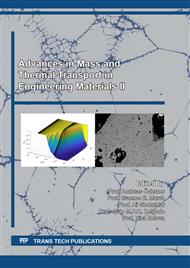p.3
p.19
p.29
p.47
p.65
p.77
p.84
p.91
Numerical Solution Strategies in Permeation Processes
Abstract:
In this work, the strategy for numerical solutions in transport processes is investigated. Permeation problems can be solved analytically or numerically by means of the Finite Difference Method (FDM), while choosing the Euler forward explicit or Euler backwards implicit formalism. The first method is the easiest and most commonly used, while the Euler backwards implicit is not yet well established and needs further development. Hereafter, a possible solution of the Crank-Nicolson algorithm is presented, which makes use of matrix multiplication and inversion, instead of the step-by-step FDM formalism. If one considers the one-dimensional diffusion case, the concentration of the elements can be expressed as a time dependent vector, which also contains the boundary conditions. The numerically stable matrix inversion is performed by the Branch and Bound (B&B) algorithm [2]. Furthermore, the paper will investigate, whether a larger time step can be used for speeding up the simulations. The stability range is investigated by eigenvalue estimation of the Euler forward and Euler backward. In addition, a third solver is considered, referred to as Combined Solver, that is made up of the last two ones. Finally, the Crank-Nicolson solver [9] is investigated. All these results are compared with the analytical solution. The solver stability is analyzed by means of the Steady State Eigenvector (SSEV), a mathematical entity which was developed ad hoc in the present work. In addition, the obtained results will be compared with the analytical solution by Daynes [6,7].
Info:
Periodical:
Pages:
29-46
Citation:
Online since:
December 2021
Price:
Сopyright:
© 2021 Trans Tech Publications Ltd. All Rights Reserved
Share:
Citation:


